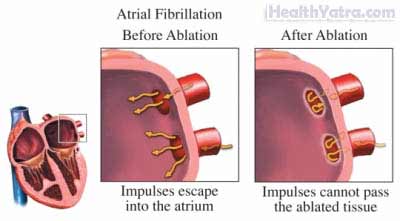সংজ্ঞা
Radiofrequency ablation uses heat to destroy abnormal tissue.
পদ্ধতির কারণ
Radiofrequency ablation is used to treat:
- Cancerous tumors in the liver, bone, kidney, breast, lung, or adrenal gland, particularly those that have not responded, or are unlikely to respond to surgery and/or chemotherapy alone (often used to treat tumors that have spread)
- Cardiac arrhythmias (irregular and/or rapid heart rhythms due to abnormal electrical conduction pathways)
- Benign prostatic hyperplasia (BPH) —condition in which enlarged areas of the prostate may be compressing the urethra (the tube that carries urine from the bladder out of the body)
- Overgrown areas of the soft palate that may be responsible for severe snoring and/or sleep apnea (periods of time when breathing stops during sleep)
- Pain from soft tissue tumors or disease that has spread
- Severe nerve pain
- ভ্যারিকোজ শিরা

সম্ভাব্য জটিলতা
Complications are rare, but no procedure is completely free of risk. If you are planning to have ablation, your ডাক্তার একটি তালিকা পর্যালোচনা করবে সম্ভাব্য জটিলতা, যার মধ্যে অন্তর্ভুক্ত থাকতে পারে:
- অস্বস্তি
- Bruising or bleeding
- সংক্রমণ
- Lung collapse upon insertion of the probe (when the procedure involves the lung, liver, or upper kidney)
- Blood clots or damage to heart muscle or conduction pathways after procedures on the heart
- Liver abscess (small, localized collection of pus within a cavity left by the destroyed tissue)
- Damage to tissue surrounding the target area
জটিলতার ঝুঁকি বাড়াতে পারে এমন কারণগুলির মধ্যে রয়েছে:
- Bleeding problems
- Active infection
কি আশা করা যায়
পদ্ধতির আগে
- Your doctor may order:
- রক্ত পরীক্ষা
- Electrocardiogram (EKG) —a test that records the electrical currents passing through the heart muscle
- Imaging tests like x-rays, ultrasound, or MRI
- Ask your doctor if you need to avoid eating or drinking before the procedure.
এনেস্থেশিয়া
You will most likely be given a sedative to help you relax. Local anesthesia will be used to numb the area. If this is done as part of another surgery, you may havegeneral or spinal anesthesia.
পদ্ধতির বর্ণনা
An IV will be placed to give you fluids and medicine to help you relax. Your heart rate, breathing, and blood pressure will be monitored. The area where the probe will be inserted is numbed.
The probe will be inserted into or directly up against the abnormal tissue. CT,ultrasound, or MRI images may be used to help guide the probe. In some cases, once the probe is inserted, a number of electrodes will be placed into the area. This will let the doctor treat a larger area of tissue.
A small amount of heat will be introduced through the probe. The heat will destroy the abnormal tissue. The probe may be repositioned to destroy other areas of tissue.
অবিলম্বে প্রক্রিয়া পরে
You will be monitored for 2-3 hours after the procedure.
কতক্ষণ এটা লাগবে?
About 10-60 minutes
এটা কতটা আঘাত করবে?
Anesthesia will prevent pain during the surgery. You will be given medicine to help prevent most pain or discomfort.
গড় হাসপাতালে থাকার
It may be possible to leave the hospital on the same day of the procedure. You may need to stay overnight for your doctor to monitor you. Speak to your doctor to see if this is an option in your case.
পোস্ট-প্রক্রিয়া যত্ন
Do not drive within the first 24 hours after the procedure. You may be asked to avoid strenuous activities. Be sure to follow your doctor’s instructions .
আপনার ডাক্তারকে কল করুন
আপনি হাসপাতাল ছেড়ে যাওয়ার পরে, নিম্নলিখিতগুলির মধ্যে যেকোনটি ঘটলে আপনার ডাক্তারের সাথে যোগাযোগ করুন:
- জ্বর এবং ঠাণ্ডা সহ সংক্রমণের লক্ষণ
- লালভাব, ফোলাভাব, ক্রমবর্ধমান ব্যথা, অত্যধিক রক্তপাত, বা ছেদ স্থান থেকে কোনো স্রাব
- ব্যথা যা আপনি ওষুধ দিয়ে নিয়ন্ত্রণ করতে পারবেন না
- Cough, shortness of breath, heart palpitations, or chest pain
- বমি বমি ভাব এবং বমি
জরুরী পরিস্থিতিতে, অবিলম্বে চিকিৎসা সহায়তার জন্য কল করুন।
